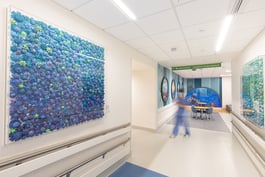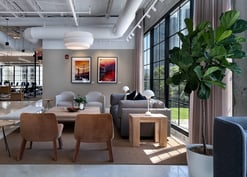Designing inclusive environments in healthcare settings supports the physical, emotional, and psychological well-being of patients, families, and staff. Multimodal art emerges as a powerful tool in this effort, offering accessible engagement and meaningful positive distraction. Through intentional design, multisensory experiences can enrich and humanize clinical spaces, fostering a deeper sense of comfort, healing, and connection.
Understanding Multisensory Art and the Importance of Accessibility and Inclusivity in Healthcare Art
Multisensory art engages more than just the visual sense—it can incorporate sound, texture, movement, and spatial awareness, creating immersive environments that stimulate multiple areas of perception (Allitt et al., 2024). These elements might include:
- Visual: Colorful murals, projections, kinetic sculptures, and visual artworks,
- Auditory: Immersive soundscapes or interactive musical/noise elements.
- Tactile: Textured surfaces or sculptural elements designed to be touched or moved.
- Proprioceptive: Art that encourages movement or mindful interaction with space.
When thoughtfully implemented, multisensory art bridges gaps in accessibility, creating spaces that engage users across a wide range of ages, abilities, and circumstances. It can serve as a powerful form of communication and comfort for individuals with cognitive impairments, sensory processing challenges, physical disabilities, or language barriers (Arts, Health, and Wellbeing, 2018).
A compelling example of multimodal healthcare design interventions is StretchCOLOR and StretchPLAY, two textile-based installations developed for children with Autism Spectrum Disorder (ASD). These flexible environments use textile structures that respond to touch and movement, encouraging sensory engagement through color shifts, soft resistance, and immersive spatial interaction. Designed to align with the specific strengths and sensitivities of children with ASD, these installations support behavioral regulation and curiosity (Ahlquist, 2016). .jpg?width=750&height=500&name=TBP_2110-HDR-Edit%20(1).jpg)
The Therapeutic Benefits of Multisensory Environments
In clinical settings, calming and engaging stimuli, such as visual art, soft lighting, ambient sounds, or gentle textures, can significantly reduce stress, anxiety, and perceived pain for patients and staff (Cavanaugh et al., 2020). These elements work together to support restorative environments, which aim not just to minimize harm but actively promote healing and emotional regulation.
Grounded in Ulrich’s theory of supportive design and salutogenic (health-focused) design principles, multisensory art acts as a positive distraction, redirecting attention away from clinical stressors and toward emotionally nourishing experiences. This sensory redirection helps shift the nervous system out of a state of hypervigilance—often triggered by sterile, high-stimulus medical settings—and into a state of parasympathetic regulation, where rest and recovery are prioritized over fight-or-flight responses (Cavanaugh et al., 2020).
These therapeutic effects are particularly valuable in high-stress or long-duration care environments. In pediatric units, for example, immersive visuals or interactive installations can reduce pre-procedure anxiety, making children feel safer and more at ease. In behavioral health settings, sensory walls or textured art can provide soothing tactile feedback and grounding stimuli that support emotional self-regulation. In long-term care facilities, multisensory experiences can help reduce agitation, improve mood, and enhance orientation, especially for residents living with dementia. (Lankston et al., 2010).
Additionally, spaces that integrate multimodal art foster cognitive engagement and sensory stimulation, which is proven to be particularly beneficial for patients with dementia, neurodivergent individuals, and those recovering from stress-related disorders (Chun, 2021). By offering multiple modes of interaction, these modalities foster a deeper sense of agency and orientation and promote comfort and curiosity. 
Designing Inclusive Spaces Using Multimodal Art Interventions
Implementing effective multimodal art interventions in healthcare settings requires thoughtful planning and a deep understanding of user needs (Awtuch et al., 2017). Key considerations include:
- Sensory variability: For example, while some patients may find soft lighting or ambient sound soothing, others may find the same stimuli overwhelming. Art should be adjustable, layered, or modulated to accommodate a range of sensory preferences.
- Physical accessibility: Art should be designed and placed with varying levels of mobility in mind, ensuring that all patients can engage.
- Cultural and emotional relevance: Imagery, sounds, and textures should reflect user preferences and reinforce themes that foster connection and comfort.
Involving patients, healthcare providers, and community members in the design process ensures that the final installation resonates with those it’s meant to serve. These participatory practices often lead to more meaningful outcomes and empower users to feel seen and valued in these spaces.
One example of a collaborative design approach is “The Peoples’ heART” project at Massachusetts General Hospital, led by Dr. Daniel Chonde. Recognizing the opportunity to expand the cultural relevance of hospital art, Dr. Chonde collaborated with hospital staff and local artists to curate installations that reflect the diverse backgrounds of patients and providers. This initiative integrates multisensory and emotionally relevant artwork into clinical spaces while centering equity and inclusion by actively involving the community in its development. The project aims to foster a sense of belonging by using art to transform the hospital into an environment that feels welcoming, personal, and human-centered (Brody, 2022).
Projects like "The People's heART" demonstrate how multimodal art, when rooted in collaboration and cultural awareness, can transform healthcare spaces into healing environments that support patient well-being and promote equity.
The Future of Multimodal Art in Healthcare
As technology advances, the possibilities for multimodal art implementations continue to expand. Innovations such as interactive digital walls, projection mapping, and AI-generated adaptive tools present opportunities for dynamic, personalized healing experiences supported by multimodal art interventions (Cavanaugh et al., 2020). By embracing these advancements and prioritizing inclusivity, healthcare facilities can transform traditionally clinical environments into truly healing spaces.
At TurningArt, we recently partnered with Boston Children’s Hospital to expand their existing art program and introduce new multisensory installations. One particularly inspiring addition is the “Portholes” - a series of interactive dioramas where users can manipulate the scenes using a crank handle.
As Senior Art Advisor Alyce from our Enterprise team shared:
“The BCH "Portholes" are more than just art; they are a tool that empowers patients. In a place where so much feels beyond their control, children have agency by physically manipulating the world within the porthole. As they turn the crank, the magic within comes alive - at whatever speed and for however long they want. Children are not only distracted by the scene within but by their own ability to manipulate it. With these multimodal artworks, engagement happens on many levels - visual, tactile, proprioceptive, maximizing positive distraction and the therapeutic effect.”
How TurningArt Can Help
At TurningArt, we recognize that art in healthcare isn’t just decorative - it’s deeply functional. Through curated multi-sensory and visual art solutions designed to support the full spectrum of patient experiences, these implementations can reduce anxiety, reinforce inclusivity, and foster emotional well-being.
Whether incorporating art that aligns with sensory-sensitive design principles or implementing site-specific commissions that reflect community identity, we know that every piece serves a purpose. With options for flexible rotating art programs or permanent installations, TurningArt helps healthcare facilities enrich their environments, enhance patient care, and prioritize healing through intentional design.
Connect with an Art Advisor below to learn more!

.jpg?width=332&height=177&name=_MG_0840%20copy%20(2).jpg)

.jpg?width=332&height=177&name=dtBv_067_DSC_2139_DaNil%20(2).jpg)



